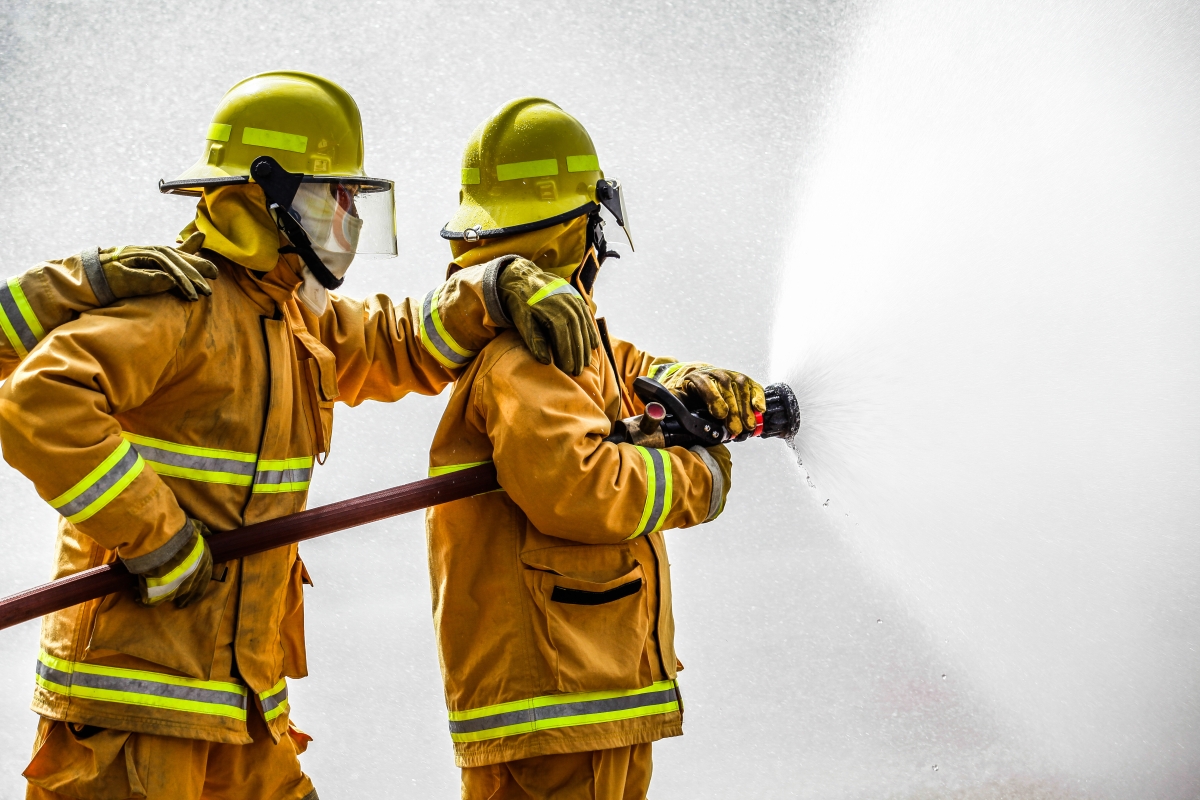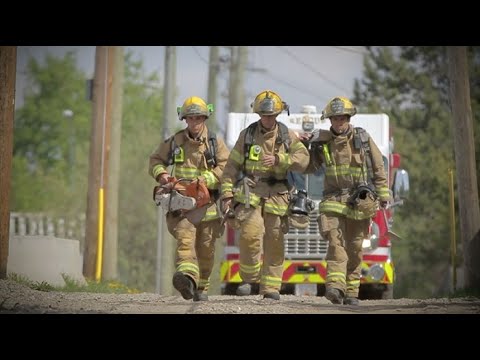Career Overview
Firefighters perform firefighting and fire prevention activities. They also help with other emergencies such as medical and public assistance calls, rescues, hazardous goods spills, motor vehicle accidents as well as other serious incidents. Firefighters must be physically fit, well co-ordinated and comfortable working from heights and in confined spaces.
Firefighters must work as a part of a team and take direction, orders and action during high-stress situations. They also need to be able to work on their own if the situation requires it. Firefighters are expected to keep their skills up to date through regular training. People in this job must be highly motivated and dedicated to helping people.
Job Titles
Duties
Firefighters:
- Respond to fire alarms and other calls for assistance, such as automobile and industrial accidents, various types of medical emergencies, bomb threats, wildfires, floods as well as other serious situations, incidents and emergencies
- Rescue people from burning buildings, motor vehicles, accident sites and other challenging situations including natural disasters such wildfires, flooding or rock/mudslides
- Control and put out fires using manual and power equipment, such as axes, water hoses, aerial ladders and hydraulic equipment as well as various firefighting chemicals
- Give first aid and other assistance
- Work on a trauma or emergency response team and provide paramedical aid to accident victims or people who are ill
- Provide emergency dispatch and incident command
- Make sure firefighting equipment operates properly and is well maintained
- Teach the public about fire prevention
- Exercise to stay physically fit
- Help the public, the police and emergency organizations during disasters
- Prepare written reports on emergencies or other incidents
- May supervise and co-ordinate other firefighters
- May conduct building inspections to ensure compliance with fire code
Earnings
Earnings is income that workers receive in exchange for their labour. Depending on the type of employment, earnings can be in the form of wages (hourly), salaries (fixed monthly or annual) or self-employed earnings.
Work Environment
# Workers Employed
4,670% Employed Full Time
80%Firefighters work for municipal, provincial and federal governments, as well as for large industrial organizations with internal firefighting services. People in this career spend a lot of their time in fire halls or training facilities preparing to handle a variety of emergency situations.
In large urban centres, firefighters typically work shifts with rotating days off. In smaller communities, they may work on a volunteer, part-time or on-call basis.
When emergencies happen, firefighters must respond quickly. At the scene of an emergency, firefighters must stay calm and level-headed. They must be able to help calm those who may have been involved or witnessed what happened.
Firefighters need to be physically fit and mentally alert since the job is demanding. Firefighters wear heavy gear when responding to emergencies and must be able to lift or carry more than 20 kilograms. They must also be able to cope with the emotional stress that comes with the job and they are encouraged to find and accept support when they need it. This type of help is usually readily available for firefighters who request it.
The work environment is often dangerous and can include extreme temperatures (both high and low), smoke as well as other airborne chemicals/irritants. Firefighters are often needed at the centre of large-scale natural and other disasters. They also may be required to get into small or tight spaces or do their work at extreme heights.
Firefighters follow strict safety procedures to maintain their own health/safety as well as the health/ safety of others.
Career Pathways
People in this career may start as a volunteer, work part-time or on-call or as an entry-level firefighter.
With additional training and several years of experience, firefighters can move to more senior positions, such as investigator, training officer, captain, lieutenant, fire battalion chief, deputy fire chief or fire chief.
Firefighters with several years’ experience, proper training and skills may specialize in hazardous materials, technical rescue or other areas.
Firefighters may also move into other jobs such as training officers, public safety educators, fire safety inspectors or fire investigators. These jobs may have more regular, daytime work hours.
Occupational Interests
It’s important to understand what kinds of occupations align with your interests.
For more about occupational interests visit Skills for the Future Workforce > Characteristics.
Here are the top occupational interest(s) for this career profile:
Education, Training and Skills
Employment requirements for firefighters may vary from one fire department to another. Completion of Grade 12 is usually required. Other requirements usually include:
- Completion of one or two years of additional post-secondary education, on-the-job training in a similar first responder role or equivalent
- Successful completion of an approved firefighter training program and National Fire Protection Association (NFPA) 1001 Level 1 and 2 Certification
- Volunteer fire departments generally provide training, which can lead to basic professional qualifications
Depending on the department, firefighter candidates must have:
- A Class 3, 4 or 5 British Columbia driver’s licence with airbrake endorsement
- A driving record that shows responsible and safe driving behaviour
They also must:
- Be medically and physically fit, as well as meet vision and hearing standards
- Pass a criminal record check
- Have CPR Level "C" and Occupational First Aid Level 3 or First Responder Level 3
Firefighter-related volunteer or work experience may be beneficial. This can include building construction, driving large or emergency vehicles, search and rescue, forest firefighting, diving, mechanical, first aid as well as paramedical experience.
Firefighters may require:
- Fluency in a language other than English
- An ability to swim and related life-saving certificates
- Volunteer work experience in the community
Education programs in B.C.

Top Skills
Every job calls for a certain set of skills. Knowing those skills is the first step in finding a good career fit.
Here, you will find the 10 most relevant workplace skills. Some are more important to achieving success in a certain career than others. These skills may come naturally to you or you may need to gain them through education, training and experience.
See the list of work-related skills below, ranked in order of importance for this career. Check out the list and see if this career matches your skills—take that first step!
Using logic and reasoning to identify the strengths and weaknesses of alternative solutions, conclusions or approaches to problems.
Giving full attention to what other people are saying, taking time to understand the points being made, asking questions as appropriate, and not interrupting at inappropriate times.
Talking to others to share information effectively.
Being aware of others’ reactions and understanding why they react as they do.
Actively looking for ways to help people.
Keeping track of and assessing your performance, other individuals, or organizations to make improvements or take corrective action.
Considering the relative costs and benefits of potential actions to choose the most appropriate one.
Adjusting actions in relation to others' actions.
Understanding written sentences and paragraphs in work-related documents.
Being able to solve novel, ill-defined problems in complex, real-world settings.
Labour Market Statistics
Discover data, facts and information that have been gathered and analyzed. Learn about the characteristics of the economy and labour market in B.C.
Employment
Find out about employment types and trends by region and industry.
Employment
4,670Employment by Region







| Region | Employment | % Employment of this Occupation |
|---|---|---|
| Cariboo | 140 | 3.0% |
| Kootenay | 165 | 3.5% |
| Mainland/Southwest | 2,880 | 61.7% |
| North Coast and Nechako | 80 | 1.7% |
| Northeast | 90 | 1.9% |
| Thompson-Okanagan | 635 | 13.6% |
| Vancouver Island/Coast | 685 | 14.7% |
Labour Market Outlook
The B.C. Labour Market Outlook is a 10-year forecast of the expected supply and demand for labour in the province. It’s usually updated every year. The purpose is to provide British Columbians with the knowledge to make informed decisions on careers, skills training, education and hiring.
Forecasted Job Openings (2025-2035)
1,940Forecasted Job Openings
Forecasted Employment Growth Rate
Composition of Job Openings
Job Openings by Region (2025-2035)







| Region | Job Openings | Avg. Annual Employment Growth |
|---|---|---|
| Cariboo | 20 | -0.3% |
| Kootenay | 60 | 0.0% |
| Mainland/Southwest | 1,140 | 0.8% |
| North Coast and Nechako | 30 | 1.0% |
| Northeast | 30 | 1.4% |
| Thompson-Okanagan | 240 | 0.7% |
| Vancouver Island/Coast | 430 | 1.9% |
Industry Highlights
Learn about the opportunities in B.C.'s major industries, including employment trends, earning potential, locations of work and more.
Forecasted Job Openings by Industry
| Industry | Job Openings (2025-2035) |
|---|---|
| Public Administration | 1,830 |
| Transportation and Warehousing | 40 |
| Construction | 20 |
| Retail Trade | 10 |
| Mining and Oil and Gas Extraction | 10 |
Insights from Industry
Career positions for firefighters are usually more available in cities or more largely populated areas. This includes Vancouver Island, the Lower Mainland, the Okanagan, Kamloops, Prince George and the Kootenays. In some regions of British Columbia, volunteer firefighters provide fire and rescue services. Working with a volunteer fire department is a good way to gain experience and professional connections for those who want paid employment.
There tends to be a steady supply of qualified candidates looking for work. Currently, there is a great deal of competition for available openings. However, ongoing retirements and competition from other industries for workers may limit the future supply of qualified firefighter candidates. Also, most fire departments are trying to increase the diversity of the force to better represent the communities they serve.
While it is a very rewarding job, the role of a firefighter can be physically, mentally and emotionally challenging. The role requires dedication and often personal sacrifice because of the work schedule. At times, the firefighter must stay overnight at the firehall, rather than at home. Firefighters work holidays, evenings and weekends. They can also be called in at a moment’s notice to work in different areas or countries in response to large-scale disasters.
Resources
-
British Columbia Professional Fire Fighters Associationwww.bcpffa.net
-
Canadian Association of Fire Chiefscafc.ca
-
Emergency Management BCwww2.gov.bc.ca/gov/content/safety/emergency-management
-
Fire Chiefs' Association of British Columbiawww.fcabc.bc.ca
-
Fire Recruitment Canadafirerecruitment.ca
-
Office of the Fire Commissionerwww2.gov.bc.ca/gov/content/safety/public-safety/fire-safety
-
Search and Rescue Safety Society of British Columbiawww.sarbc.org
-
Vancouver Fire Rescue Servicesvancouver.ca/your-government/vancouver-fire-and-rescue-services.aspx
-
Volunteer Firefighters' Association of British Columbiawww.firebc.org








